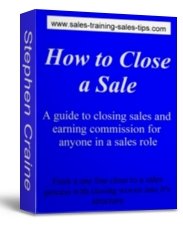| Back to Back Issues Page |
 |
|
The Sales Buzz Issue 183 - Indirect Closing Question – Could you use it to close more sales November 20, 2012 |
| Hi,
When you ask an Indirect Closing Question you are asking if the prospect will buy but if they say no you are leaving the way clear to carry on with your sales pitch. At first it looks like a simple technique but it really does have a lot of benefits and can help you close more sales...
Indirect Closing Question – Could you use it to close more salesAn Indirect Closing Question is one that if answered with a ‘Yes,’ indicates that the customer wants to buy. If it is answered with a ‘No,’ they are not necessarily saying no to buying the product.
The indirect questions have their place, and can be a useful sales closing technique in the right situation. One place I have found them very useful is when used as a trial close to test the buyer’s readiness to buy before a direct closing question such as: Would you like to place an order. The indirect question could be related to the supply of the product or service. Such as: Would you like to arrange for delivery. It could be a question about receiving a benefit. For example: Would you like to start making those improvements in production. A Yes answer to these questions would indicate a readiness to buy. But because it is not a direct question if the customer answered ‘No’, it does not build a large obstacle to the actual sale. They have only answered no to your question about delivery or production improvements. This makes it easier to overcome their objections and close the sale.
An Example of an Indirect Closing Question A good example of how to use an indirect close can be found in the closes that some people use to gain agreement to a sales appointment. When they ask the closing question on a telephone call to make a sales appointment, some sales people ask: ‘When will you be available?’ Or, ‘I’m free on Thursday morning, and Friday afternoon, which of is best for you?’ They have not asked if the prospect will meet with them, but when. This is a presupposition that takes it for granted the prospect thinks they should meet with the salesperson. If the customer objects they usually say, ‘No I’m not available at that time.’ This is an objection to the time of the meeting not the meeting itself. The salesperson then answers by trying to agree a time to meet rather than look for why they don’t want to meet.
The sales training above is a brief sample from the eBook course How to Close a Sale. If you like the idea and how it is presented you can see more about the course at How to Close a Sale...
I'm Stephen Craine from the website Sales-Training-Sales-Tips.com Thank you for subscribing to The Sales Buzz, the Free Sales Training Newsletter for all sales people, small businesses owners, and sales managers. Please feel free to copy and use the information that you find here. All I ask is that you include a credit to the newsletter or the website, and a link back to www.Sales-Training-Sales-Tips.com. You can see all the back issues of this free sales training newsletter at Sales Buzz back issues...
Send a prepared invitation to the Sales Buzz to your friends and colleagues. We've prepared an invitation for you to send. It gives your colleagues information on how to get the Sales Buzz and the 2 free sales training eBooks when they enter their email address. Open the invitation and send to as many people as you think will gain from this free newsletter. The Sales Buzz Invitation...
Ask a question, make a comment, get in touch. You can ask any question, make a comment, or simply get in touch and let me know your thoughts. To contact me, Stephen Craine, go to the contact page and simply click and type. To make a comment, or ask a question, and get it published on the website, go to Sales Training Blog page.
|
| Back to Back Issues Page |

